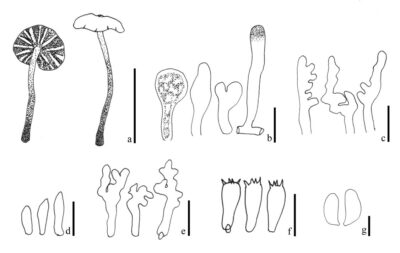Fungalpedia – Note 346, Mycetinis
Mycetinis Earle
Citation if using this entry: Bera et al. 2024 (in prep)–Fungalpedia, Basidiomycota 1
Index Fungorum, Mycobank, GenBank, Fig.1
Classification: Omphalotaceae, Agaricales, Agaricomycetidae, Agaricomycetes, Agaricomycotina, Basidiomycota, Fungi
Earle (1909) found Mycetinis, designating Mycetinis alliaceus as the type species, which is globally distributed and saprobic in nature (Peterson & Hughes 2017). Index Fungorum (2024) documented 27 records of Mycetinis; however, Wijayawardene et al. (2022) only accepted 15 species. The pileus is smooth, ranging in color from burnt reddish to brownish, becoming paler towards the margin, and initially strongly convex to globose, but with maturity, it expands to shallow convex, plane, or somewhat everted (Peterson & Hughes 2017). The lamellae are ventricose-shaped but become distinctly wavy when dried and can have free, adnate, or adnexed attachments to the stipe (Wilson & Desjardin 2005, Peterson & Hughes 2017). The stipe is centrally attached, pale, concolorous with lamellae, becomes darker downward, displays cinnamon to rusty shades, and has a mycelial pad at the base (Wilson & Desjardin 2005, Peterson & Hughes 2017). The pileipellis is composed of inflated terminal hyphae that vary in shape from subglobose to broadly clavate, lobate, or diverticulately branched and can be either pigmented or hyaline (Peterson & Hughes 2017). Basidia are narrowly clavate to nearly cylindrical and typically bear four sterigmata (Peterson & Hughes 2017). Basidiospores are smooth, hyaline, inamyloid, non-dextrinoid, acyanophilic, and thin-walled (Wilson & Desjardin 2005). Cheilocystidia are present and range in shape from cylindrical to fusoid or clavate, and are clavate without any diverticula (Wilson & Desjardin 2005, Peterson & Hughes 2017). Pleurocystidia are either absent or rarely present, and when they occur, they resemble cheilocystidia (Wilson & Desjardin 2005). Caulocystidia and clamp connections are both present.
The basidiomata of Mycetinis emit an odour of garlic-like to cabbage-like (Wilson & Desjardin 2005, Peterson & Hughes 2017). Molecular analysis (nrLSU) revealed a distinct clade comprising Marasmius alliaceus, M. opacus, M. scorodonius, M. copelandii, and M. applanatipes, which have been reclassified under the genus Mycetinis (Wilson & Desjardin 2005).
Type species: Mycetinis alliaceus (Jacq.) Earle ex A.W. Wilson & Desjardin
Basionym: Agaricus alliaceus Jacq.
Other accepted species: (Species Fungorum – search Mycetinis)
Figure 1 – Mycetinis yunnanensis (TFB3103). a Basidiomata. b Pileipellis structures of pileus disc. c Diverticulate hyphae of pileus margin. d Pleurocystidia. e Cheilocystidia. f Basidia. g Basidiospores. Scale bar: a = 1 cm, b−f = 10 µm, g = 5 µm. Re-drawn from Peterson & Hughes (2017).
References
Entry by:
Sabin Khyaju, Center of Excellence in Fungal Research, School of Science, Mae Fah Luang University, Chiang Rai, Thailand
(Edited by Ishika Bera, Samaneh Chaharmiri-Dokhaharani, & Achala R. Rathnayaka)
Published online 27 August 2024
